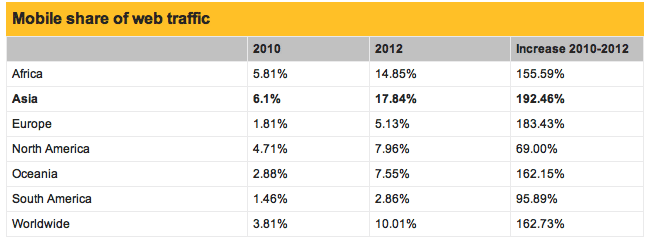Mobile Phone Internet Browsing Set to Surpass Desktop by 2014
With the take-up of smart phones, here in Australia and around the globe, rapidly increasing, the stage is set for mobile phone internet browsing to surpass desktop online browsing by 2014.

What does this astounding growth mean? Quite simply, more people searching online more often, for products, information and services. Combine this with the mind boggling number of mobile apps developed by businesses for consumers to access their goods and services and you have a tsunami of market demand happening online.
“In the past year, shoppers have clicked and spent $10 billion to $12 billion online, about 5 per cent of total retail sales of $250 billion. The executive director of the Australian Retailers Association, Russell Zimmerman, says about half the online figure was spent offshore.”
In Australia we have had the recent debate in the public arena, regarding overseas online shopping and the $1000A GST free thresh hold. With the large retailers, Harvey Norman, Myers and Target, threatening to establish or dramatically increase their own online presence if the government refuses to level the playing field. The Australian government has consistently stated, on advice from the ATO, that it is not revenue positive to collect the GST on these transactions. Later news reports have told of the widespread practise of Hong Kong online retailers to issue fake invoices understating the true worth of the sold item beneath the $1000A thresh hold.
Digital shopping is growing rapidly and has been supported by the high Australian dollar in relation to the green back and Euro. The tide is turning and the pace of this increase in online shopping will only continue to outstrip any overall increases in retail trade. The mobile phone now answers one of the main drawbacks to digital shopping over face to face retail, which has held it back in the past – the immediacy and mobility of the smart phone”s internet access allows the consumer”s desire for instant gratification versus the passive wait and see nature of desktop internet shopping.
The smart phone”s small screen and the locality of its usage, often whilst driving in a car, however, will reduce the time spent searching on browsers by the user. What this really means is that SEO will become even more vital to online businesses, as consumers will quickly choose those sites ranked at the top of keyword search results. As the percentage of shopping swings more and more to online away from retail, the digital highway will become even more crowded and the need to be seen through SEO absolutely integral to business success.
Mobile internet browsing continues to explode in Australia.
The latest Neilsen stats reveal that mobile internet usage in Australia, reached 221 million page views in March 2012, which was up from 59 million at the same time last year.
Data is also showing that consumers are using their smart phones and tablets to browse, whilst watching TV in the evenings, and are very likely to be using these devices to check out more detailed information about programs and advertised products and services. Click through rates are increasing by 10% at these times in comparison to day time results for these mobile campaigns.
Organic SEO, which is real SEO rather than Adwords, will continue its surge to marketing prominence and become the bench mark for quality websites in their bid for increased market share. Onsite SEO and offsite SEO, will become better known terms, as companies seek the magic elixir of page ranking results. I predict that this decade will be the time when SEO replaces many of the old technologies in its marketing importance and that businesses will wake up to this fact. The world is changing incredibly quickly and we have reached the tipping point.
Tags In
Related Posts
Categories
- Corporate SEO (34)
- Corporate SEO Company (18)
- Corporate Videos (1)
- Enterprise Social Networking (1)
- Fashion SEO (7)
- Featured (22)
- Inspiration (1)
- Medical SEO (8)
- Offsite SEO (12)
- Prestige Brand SEO (21)
- Search Engine Optimisation (31)
- SEO Articles (35)
- SEO Australia (26)
- SEO Case Studies (20)
- SEO Sydney (19)
- SEO Sydney Clients (18)
- Social Media (8)
- Style (3)
- Tips & tricks (8)
SEO Client Testimonials
"When we started with Stewart and his team in 2011 we had one website and a small clinic in Artarmon. Now we've moved to massive premises in the centre of Chatswood, thanks to the influx of patients from our 4 new websites." Emma Boulton, Clinic 66.
"Our lives have gone forward dramatically since we got involved with the Corporate SEO Company. We've had media interest from all the major newspapers, won awards, and got our chai product not just into Coles and Woolies, but a stack of new countries." Martin Buggy, Bondi Chai.





